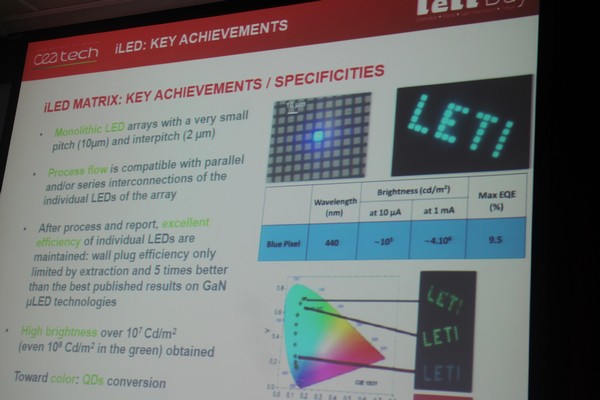(Authors: Judy Lin, Chief Editor, LEDinside and Philip Chang, Analyst, LEDinside)
Micro LEDs are gaining traction in the LED industry since it is a technology that industry experts view as capable of breaking LCDs low light efficiency, and achieve “real LED display” technology. Current LCD designs are very inefficient in light output, with only an estimated 10% light emission. Light emitted from the LED backlight module has to travel through polarization filters, TFT, liquid crystals, and color filters, about 90% of light is trapped in these layered structures.
French nanotechnology expert CEA LETI spoke about how emerging display technologies rising from wearable and augmented reality markets are requiring a different type of LED backlight technology, and how this is opening up market opportunities for micro LED array markets during a Taiwan Solid State Lighting seminar organized by Industrial Technology Research Institute of Taiwan (ITRI) recently.
 |
|
CEA LETI's current micro LED technology progress. (LEDinside) |
Smart lighting, IoT and emerging wearable device and augmented reality devices are ushering in a demand for new display technologies. Virtual reality device or augmented reality wearable devices brightness requirement is 5,000 nits, which OLED does not necessarily meet. Inorganic micro LEDs share similar properties of being flexible and highly scalable. Micro LEDs that are arranged in monolithic LED arrays can achieve a very small pitch of 10 micrometers (µm), which the company intends to bring down to 1µm, said Ivan-Christophe Robin, Strategic Marketing Manager, CEA LETI, France.
The LEDs showcased by CEA LETI were iLED matrix have a blue light emission of 440 nm delivering EQE 9.5% and brightness of 107 Cd/m2, while its green light performance has an EQE of 5.9% and brightness of 108 Cd/m2. The company has been using quantum dots for full color displays.
Inorganic micro LEDs are highly scalable and can be easily transferred to wearable device markets, automotive lighting, general lighting, HUD and even biophotonics. The new LEDs small size makes it applicable in optogenetics, where LEDs are implanted into rats or other animals’ brains to control neuron activity. Currently, CEA LETI aims to enter the smart lighting market with its micro LED products, and in the next two to three years enter the HUD and HMD market as it eyes the virtual reality market. The company’s goal in the next 10 years is to enter large display sector with the technology.
Advantages of using micro LEDs over OLED in certain screen applications is it can bring together small pitch and brightness that typically is better than OLED performance. Micro LED light extraction performance can be improved by using doped transparent layers and simulating the whole stack of micro LEDs. But there are still several challenges the technology needs to overcome before it can reach mass production stage.
One of the main challenges is making a glare free-active matrix capable of delivering high current densities, and different application sectors are subjected to different technology issues. In HUD and projector applications substrate removal, extraction report of conversion layers can be difficult. In biotronics bounding is often an issue. CTE mismatch, microarray alignment accuracy, max acceptable temperature and pressure for various device applications can all present technology barriers. In certain applications the micro LED has to be processed using cold process, since there is a shift of 0.9 pixel for every 1,000 pixels resulting in pixel mismatch.
CEA LETI’s current technology is focused on GaN LED arrays interconnected on silicon using commercialized equipment, and is working on sapphire removal which would increase external quantum efficiency. The company is testing hybridization micro LEDs at the moment, which is robust and more reliable than what can currently be achieved with micro boules. According to Robin, hybridization is a solution to removing dead pixels, which are unwanted in displays.
Micro LEDs are viewed in the LED industry as the future for display technology, and there is a bright future ahead for the technology. Through different phases CEA LETI is targeting smart lighting, HUDs in virtual reality applications, and eventually large display markets in the next 10 years. Overcoming manufacturing obstacles is still an issue for companies entering this sector.





 CN
TW
EN
CN
TW
EN






